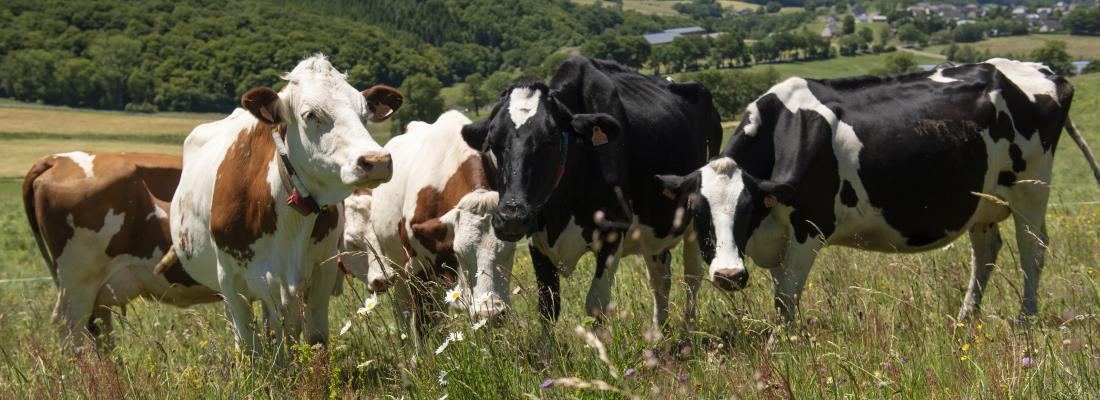Climate change and risks Reading time 6 min
Resilience and robustness of dairy cows to variations in feed intake
Published on 09 April 2025

Our objective was to compare the production and metabolic responses of 22 Montbéliarde (MONT) and 18 Holstein (HOLS) multiparous cows during the periparturient period, and during a sequential nutritional challenge (SNC), consisting of 4 successive induced short feed restrictions each separated by a refeeding period, to explore breed differences in robustness (ability to maintain lactation function during successive challenges) and resilience (ability to recover after each challenge).
Cows were studied from 4 weeks before expected calving until 158 ± 9 DIM (mean ± SD). Milk and ECM yields were greater in HOLS than in MONT during both the early- (i.e., from calving to wk 10) and mid-lactation (i.e., from wk 18 to 22) periods, whereas BCS was greater in MONT than HOLS.
During early lactation, energy balance was lower (5 vs. 16 MJ/d) and plasma NEFA (270 vs. 163 μM) were greater for HOLS than MONT, respectively. Cows in third-and-greater lactation secreted more ECM, and had delayed resumption of luteal activity compared with second-lactation cows. The SNC started at 87 ± 9 DIM and consisted of a sequence of four 4-d periods of feed restriction (FR), during which feed allowance was calculated to meet 50% of individual energy requirements (FR1, FR2, FR3, FR4), each of them being followed by an ad libitum intake period. Cows were allowed 10 d of ad libitum intake between FR1 and FR2 to study the recovery and compare it with the recovery following FR4, and 3 d of ad libitum intake between FR2, FR3, and FR4 to study responses to repeated FR. Feed allowance met 59% to 67% of energy requirements during FR1 through FR4, as milk secretion decreased with successive FR.
Breed differences in milk secretion persisted throughout the nutritional challenges, but were more pronounced during the first 2 FR: Uncorrected milk yield was greater for HOLS throughout the entire SNC, whereas ECM and plasma NEFA concentrations and milk fat yield were greater for HOLS than MONT during FR1 and FR2, but not FR3 and FR4, suggesting a reduced ability of HOLS to mobilize and transfer fatty acids into milk with successive FR, and indicating altered robustness of HOLS to maintain high milk yield. Resilience for ECM yield did not differ between breeds.
Cows were able to respond to and recover from the SNC by decreasing milk secretion during FR, undergoing acute metabolic adaptations to support lactation, and recovering DMI during each refeeding period. Cow rankings for ECM yield were maintained consistently from early lactation throughout the SNC periods (rs = 0.59 to 0.90), suggesting that dairy potential was a major driver of responses during the SNC for both HOLS and MONT.
This work is part of the European Union's GenTORE H2020 project (no. 727213) and was conducted in the UE Herbipôle (INRAE, UE1414).
Reference: Pires, J.A.A.; de la Torre, A.; Barreto-Mendes, L.; Cassar-Malek, I.; Ortigues-Marty, I.; Blanc, F., 2025. Production and metabolic responses of Montbéliarde and Holstein cows during the periparturient period and a sequential feed-restriction challenge. Journal of Dairy Science, 108 (2): 1495-1508 - https://doi.org/10.3168/jds.2024-25488
